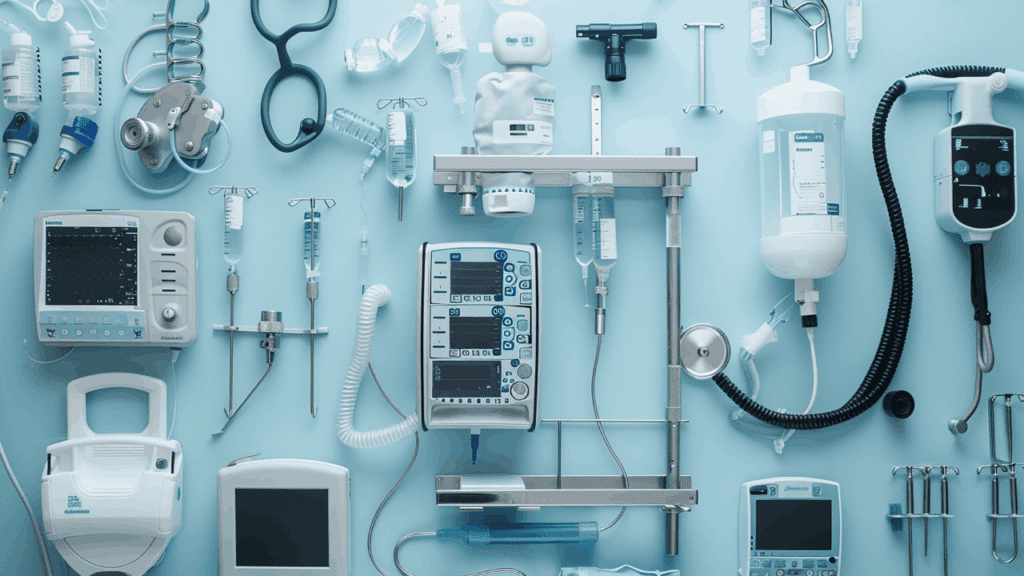The healthcare sector in Bangladesh has been experiencing rapid growth over the past few decades, driven by increasing public awareness, rising incomes, and government initiatives aimed at improving healthcare access and quality. As the country continues to progress, the demand for modern healthcare services has surged, necessitating the import of advanced medical equipment. This article delves into the growth of the medical equipment import industry in Bangladesh, exploring the factors driving its expansion, the challenges it faces, and the future outlook for this critical sector.
Brief Overview of Bangladesh’s Healthcare Sector
Bangladesh’s healthcare sector is a vital component of the country’s development strategy. With a population exceeding 160 million, the need for efficient healthcare services is immense. Over the years, significant strides have been made in improving healthcare delivery, with both the public and private sectors playing pivotal roles. The government’s commitment to achieving Universal Health Coverage (UHC) by 2032 has led to increased investments in healthcare infrastructure and services. Despite these efforts, the healthcare system still faces challenges, including limited access to advanced medical technologies, which are essential for diagnosing and treating complex conditions.
Importance of Medical Equipment in Healthcare Delivery
Medical equipment forms the backbone of modern healthcare delivery. From diagnostic machines that help detect diseases early to surgical instruments that enable life-saving procedures, medical equipment is indispensable in ensuring quality healthcare. In Bangladesh, where the burden of both communicable and non-communicable diseases remains high, the availability of advanced medical equipment is crucial in enhancing patient outcomes. However, the domestic production of such equipment is limited, making imports a critical source of medical technology in the country.
Growth of the Medical Equipment Import Industry in Bangladesh
The import of medical equipment in Bangladesh has seen significant growth in recent years, fueled by the rising demand for advanced healthcare services. According to industry estimates, the market for medical equipment imports has expanded at an annual rate of 15-20% over the past decade. This growth is reflective of the increasing healthcare expenditure, both at the governmental and individual levels, as well as the expanding network of private healthcare providers seeking to offer state-of-the-art medical services.
Factors Driving the Growth of the Medical Equipment Import Industry
Several factors contribute to the growth of the medical equipment import industry in Bangladesh:
Increasing Healthcare Expenditure:
With rising incomes and greater awareness of health issues, Bangladeshis are spending more on healthcare. This increased expenditure has driven demand for better healthcare facilities, which, in turn, has spurred the need for advanced medical equipment.
Rise in Demand for Advanced Medical Treatments:
As the population ages and the prevalence of chronic diseases such as diabetes, cardiovascular diseases, and cancer increases, there is a growing demand for advanced medical treatments. These treatments often require specialized equipment, much of which is not manufactured domestically and must be imported.
Government Initiatives to Improve Healthcare Infrastructure:
The Bangladeshi government has undertaken several initiatives to improve healthcare infrastructure across the country. This includes upgrading hospitals, establishing new medical colleges, and increasing the number of healthcare facilities in rural areas. These initiatives have created a significant demand for imported medical equipment.
Lack of Domestic Manufacturing Capabilities:
While Bangladesh has made strides in various manufacturing sectors, the production of high-tech medical equipment remains underdeveloped. The absence of robust domestic manufacturing capabilities means that the country relies heavily on imports to meet its medical equipment needs.
Major Categories of Imported Medical Equipment
The medical equipment imported into Bangladesh can be broadly categorized into the following segments:
Diagnostic Equipment:
This category includes essential tools such as X-ray machines, ultrasound scanners, and MRI machines. These devices are critical in the early detection and diagnosis of diseases, enabling timely and effective treatment.
Surgical Equipment:
Bangladesh imports a wide range of surgical instruments, including operating tables, laparoscopic instruments, and endoscopes. These tools are essential for performing various surgical procedures, from routine operations to complex interventions.
Medical Consumables:
Items such as syringes, catheters, and dressings fall under this category. These consumables are necessary for everyday medical practice, ensuring that healthcare providers can deliver safe and effective care.
Laboratory Equipment:
Analyzers, microscopes, and centrifuges are among the laboratory equipment imported into Bangladesh. These devices are vital for conducting medical tests and research, supporting the diagnosis and treatment of diseases.
Key Import Sources and Trade Patterns
Bangladesh imports medical equipment from a diverse range of countries, with major sources including the United States, Germany, Japan, China, and India. Each of these countries has a well-established medical equipment manufacturing industry, offering products that vary in terms of price, quality, and technological advancement.
Trade Trends: Import Volumes and Values
The trade patterns in the medical equipment import industry in Bangladesh are influenced by several factors. Import volumes and values have consistently increased over the years, reflecting the growing demand for advanced healthcare technologies. The total value of medical equipment imports is estimated to be in the hundreds of millions of dollars annually, with diagnostic and surgical equipment accounting for the largest share.
Factors Influencing Import Decisions
Several factors influence decisions related to the import of medical equipment in Bangladesh, including:
- Price: Cost considerations are critical, especially for smaller healthcare providers and public hospitals with limited budgets.
- Quality: The quality and reliability of medical equipment are paramount, as they directly impact patient safety and treatment outcomes.
- Regulatory Compliance: Importers must ensure that the equipment meets local regulatory standards, which can influence the choice of suppliers.

Challenges Faced by the Medical Equipment Import Industry
Despite its growth, the medical equipment import industry in Bangladesh faces several challenges:
Regulatory Hurdles and Compliance Issues:
Importers often face difficulties navigating the complex regulatory landscape, which includes obtaining approvals and ensuring compliance with local standards.
Quality Concerns and Counterfeit Products:
The prevalence of counterfeit medical equipment is a significant concern, as it poses risks to patient safety and undermines the credibility of the healthcare system.
Logistics and Supply Chain Challenges:
Efficient logistics and supply chain management are essential for the timely delivery of medical equipment. However, importers often encounter challenges related to customs clearance, transportation, and storage.
Currency Fluctuations and Exchange Rate Risks:
As medical equipment is primarily imported, fluctuations in currency exchange rates can significantly impact the cost of imports, posing risks to profitability.
Government Policies and Initiatives
The government of Bangladesh plays a crucial role in shaping the medical equipment import industry through various policies and initiatives:
Import Duty Structures and Tax Incentives:
The government has implemented favorable import duty structures and tax incentives to encourage the import of essential medical equipment, particularly those not produced domestically.
Quality Control Measures and Regulatory Frameworks:
To ensure the safety and efficacy of imported medical equipment, the government has established quality control measures and regulatory frameworks that importers must adhere to.
Initiatives to Support Domestic Manufacturing:
While the focus remains on imports, the government is also taking steps to promote domestic manufacturing of medical equipment through incentives and support for local manufacturers.
Future Outlook and Opportunities
The future of the medical equipment import industry in Bangladesh appears promising, with several growth opportunities on the horizon:
Growth Projections:
Industry experts predict continued growth in the medical equipment import market, driven by ongoing healthcare infrastructure development and the rising demand for advanced medical technologies.
Emerging Trends and Technologies:
Advances in medical technology, such as telemedicine, wearable health devices, and artificial intelligence, present new opportunities for importers to introduce innovative products to the Bangladeshi market.
Potential Areas for Investment and Collaboration:
There are significant opportunities for international companies to invest in Bangladesh’s healthcare sector, either through direct imports or collaborations with local partners.
Challenges and Opportunities for Domestic Manufacturers:
While the focus remains on imports, there is also potential for the development of a domestic medical equipment manufacturing industry, particularly in collaboration with international companies.
Conclusion
The medical equipment import industry in Bangladesh is a dynamic and rapidly growing sector, driven by the country’s expanding healthcare needs and the increasing demand for advanced medical technologies. Despite facing challenges such as regulatory hurdles and logistics issues, the industry offers significant opportunities for growth and investment. Moving forward, a concerted effort by the government, industry stakeholders, and international partners will be essential in ensuring that Bangladesh’s healthcare system continues to improve, ultimately enhancing the quality of life for its people.
FAQs: Medical Equipment Import Industry in Bangladesh
What is the current state of the medical equipment import industry in Bangladesh?
The medical equipment import industry in Bangladesh is experiencing rapid growth, driven by increasing healthcare demands, government initiatives, and a lack of domestic manufacturing capabilities.
What types of medical equipment are commonly imported into Bangladesh?
Bangladesh imports various types of medical equipment, including diagnostic equipment (like X-ray machines and MRI scanners), surgical instruments, medical consumables (such as syringes and dressings), and laboratory equipment.
Which countries are the primary sources of medical equipment imports for Bangladesh?
The main countries exporting medical equipment to Bangladesh include the United States, Germany, Japan, China, and India.
What factors are driving the growth of the medical equipment import industry in Bangladesh?
Key factors include rising healthcare expenditure, increased demand for advanced medical treatments, government efforts to improve healthcare infrastructure, and the limited domestic production of medical equipment.
What challenges does the medical equipment import industry face in Bangladesh?
Challenges include regulatory hurdles, quality concerns, counterfeit products, logistics and supply chain issues, and currency exchange rate fluctuations.
How does the Bangladeshi government support the medical equipment import industry?
The government supports the industry through favorable import duty structures, tax incentives, quality control measures, and initiatives to promote domestic manufacturing.
What is the future outlook for the medical equipment import industry in Bangladesh?
The industry is expected to continue growing, with opportunities for introducing emerging technologies, investment in healthcare infrastructure, and potential development of domestic manufacturing capabilities.
How does imported medical equipment impact healthcare in Bangladesh?
Imported medical equipment plays a critical role in improving healthcare delivery by providing advanced diagnostic, surgical, and laboratory tools, which enhance patient care and outcomes.

